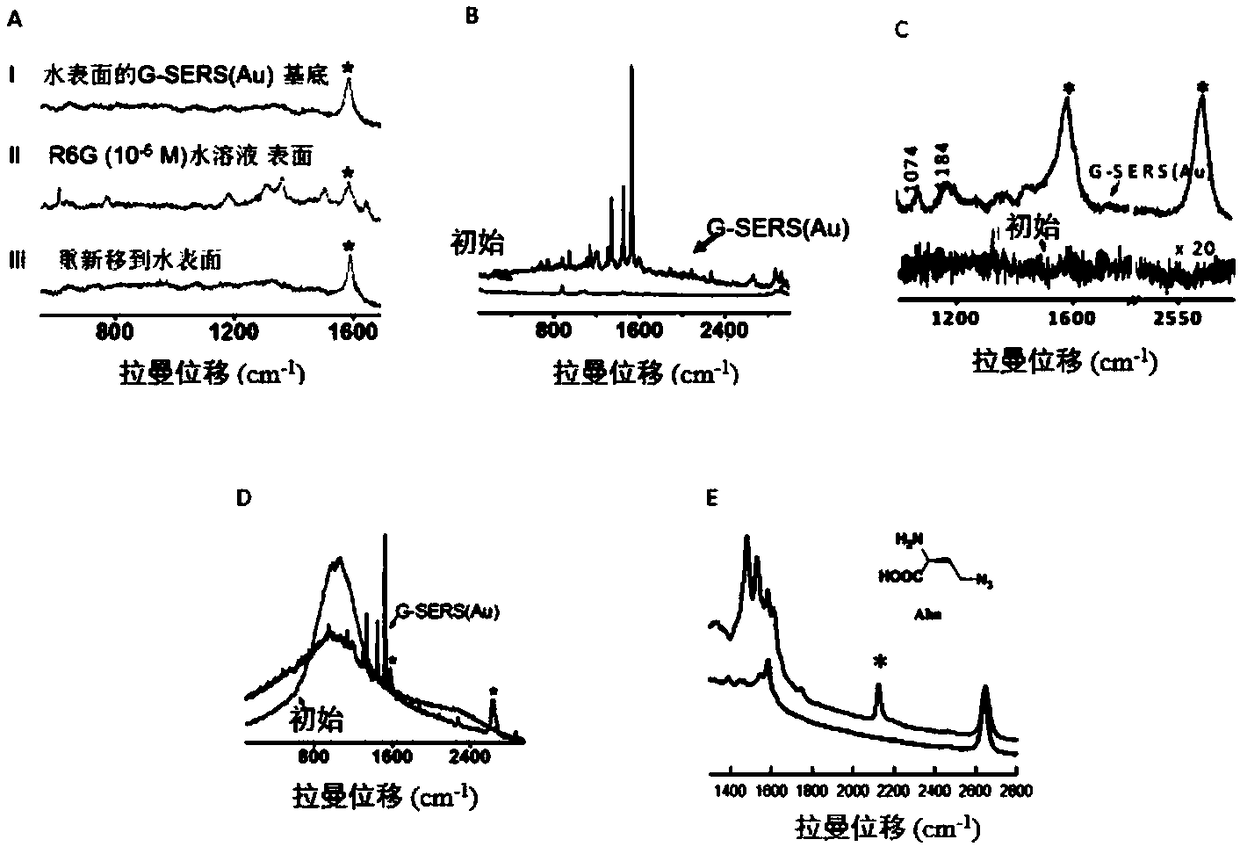Graphene-based flexible enhanced Raman substrate and preparation method thereof, and Raman analysis method
A Raman substrate and flexible substrate technology, which is applied in the application field of graphene functional materials, can solve the problems of inability to realize online detection of Raman spectroscopy, inability to realize the back-incidence detection mode well, etc., and achieve the effect of online quantitative detection.
- Summary
- Abstract
- Description
- Claims
- Application Information
AI Technical Summary
Problems solved by technology
Method used
Image
Examples
Embodiment 1
[0059] Example 1. Qualitative analysis of Raman molecules on surfaces with different shapes using G-SERS substrates
[0060] (1) Detection of aqueous phase system by G-SERS substrate. Such as image 3 As shown in a, the upper figure is a typical experimental device diagram of the G-SERS substrate detection solution system. As can be seen from the figure below, on the surface of ultrapure water, only the signal peak (line I) of graphene itself is observed in the Raman spectrum; and when the same substrate is placed at 1.0×10 -5 When detecting in the R6G aqueous solution of M, the characteristic peak (line II) of the R6G molecule can be clearly seen in the Raman spectrum; when the flexible substrate is rinsed with deionized water and placed on the surface of the aqueous solution again, the R6G molecular The signal disappears completely and only the signal of graphene is seen (line III). This demonstrates that the flexible G-SERS substrate can be used in a cyclic detection pro...
Embodiment 2
[0065] Example 2, Quantitative Analysis of Crystal Violet (CV) Molecules Using G-SERS Substrate
[0066] The flexible G-SERS substrate in the present invention can be used for Raman quantitative detection.
[0067] The premise of G-SERS substrate for quantitative analysis is that the molecules to be tested can be adsorbed uniformly on the graphene surface. The graphene surface uniformly adsorbs molecules to form a double-layer structure of the molecules to be measured and the internal standard molecules, so that the relative value of the molecules and the internal standard molecules of graphene is a definite value, so as to achieve the purpose of quantification. The quantitative models involved are as follows: Figure 4a as well as Figure 4b shown.
[0068] In order to verify that the distribution of Raman molecules on the graphene surface is uniform, the transfer on Si / SiO 2 Graphene on the surface of the substrate is used as a Raman-enhanced substrate to detect the unifo...
Embodiment 3
[0078] Example 3, Quantitative detection of rhodamine B (RhB) molecules in the actual system using G-SERS substrate
[0079] The invention uses the G-SERS substrate to quantitatively analyze the actual system of rhodamine B (RhB) molecules. The RhB molecule is a synthetic dye molecule with a bright rose red color. It is often used as an industrial dye for papermaking and leather, but some unscrupulous traders use it as a food additive, and long-term intake of this dye molecule can lead to cancer. The invention detects a series of Raman spectra of RhB standard solutions with different concentrations, and obtains measurement curves. Such as Figure 9 As shown in c, for the pure RhB solution and the beverage sample with added RhB molecules, it can be clearly seen that RhB is at 1651cm -1 (aromatic ring C-C bending vibration and C=C stretching vibration), while the blank beverage sample does not appear the Raman peak of RhB. I can be obtained by calculation R The values are ...
PUM
 Login to View More
Login to View More Abstract
Description
Claims
Application Information
 Login to View More
Login to View More - R&D
- Intellectual Property
- Life Sciences
- Materials
- Tech Scout
- Unparalleled Data Quality
- Higher Quality Content
- 60% Fewer Hallucinations
Browse by: Latest US Patents, China's latest patents, Technical Efficacy Thesaurus, Application Domain, Technology Topic, Popular Technical Reports.
© 2025 PatSnap. All rights reserved.Legal|Privacy policy|Modern Slavery Act Transparency Statement|Sitemap|About US| Contact US: help@patsnap.com



